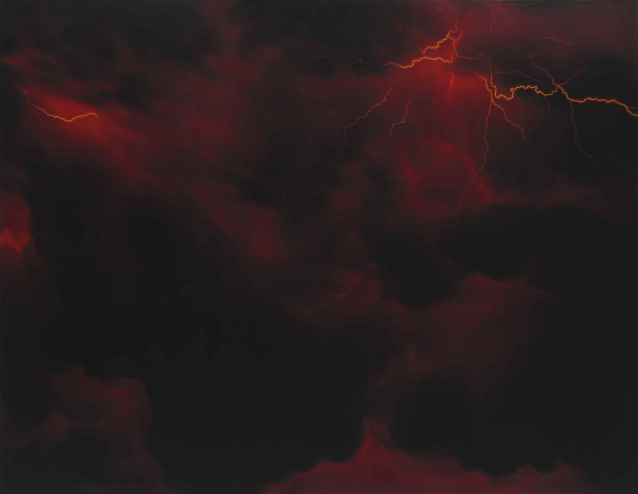“This show is to point out that [Jack Goldstein’s] paintings are his greatest contribution to art history,” Adam Lindemann told me a few weeks ago at a press preview at Venus Over Manhattan. The show, titled “Where Is Jack Goldstein?” celebrates the last work made by the artist before he all but disappeared from the New York art world.
Lindemann’s search began during a dinner at Gavin Brown’s house, when he happened to notice a Rirkrit Tiravanija painting bearing the question “Where Is Jack Goldstein?” Intrigued, Lindemann then went to dinner with Tiravanija, who had been an art handler for Goldstein as well as a great admirer, and Tiravanija gave Lindemann permission to use the title for a show. Lindemann then called up his friend Rob Pruitt, who suggested that he talk to Goldstein’s old studio assistant Ashley Bickerton, a Cal Arts grad and a bit of an art star himself. After some Facebook hunting, Lindemann, while on the beach, finally got an international phone call from Bickerton, who was on a different beach, in Bali. Bickerton agreed to write a 3,000 word personal account of his years with Goldstein to accompany the show.
It all sounds really, really blue chippy, but it seems fitting for a tribute to Goldstein, who was all but crushed between the high concept and commercial world. While Goldstein rose to fame in the late 70s as part of the Pictures Generation, he would later be thought of by some in the conceptual art community as a sell-out. Early on, he had been making short films of quick phenomena (MGM, The Jump), and later moved to paintings designed to be sold to the rich at a high price (often, nighttime lightning and explosions). It was soon after making this body of work that Goldstein fell into a severe depression, disappeared to the California desert for most of the 90s, and, despite a late revival in interest in his work, committed suicide in 2003.
As though to illustrate the equal importance of work in both media, non-paintings ease the transition to the main gallery. Across from the front door, one finds “Burning Window,” a red paper window frame set in front of flickering light, and to the right, “Shane,” Goldstein’s looped 1974 film of a German Shepherd barking. The darkened main gallery comprises spotlit explosions: large-scale photographic nighttime paintings of lightning, eclipses, fireworks, and war planes. The paintings only differ conceptually insofar as they’re physical objects, they’re more expensive, and they don’t animate.
Similar to the films, Goldstein didn’t do any of the actual labor of making them. “Not one is signed by Jack Goldstein, none are painted by Jack. He’s the director of an experience, neither the cinematographer, nor the actor,” Lindemann explained. That, he said, was a problem in the 80s, when everyone made their own paintings.
If directing an experience has to do with Goldstein’s contribution to art history, then one could argue that he’s paved the way for everyone from Koons to Relational Aesthetics. Books like “Jack Goldstein and the Cal Arts Mafia” argue as much. Tiravanija cites him as an influence. Marc Handelman and Trevor Paglen come to mind. Lindemann noted that most big artists don’t paint their own work now, notably Jeff Koons and Damien Hirst—not a particularly uplifting legacy for painting, but valid. “I don’t think we’ll ever have a better show,” Lindemann joked. “This is it, I’m thinking of closing.”
“Most of these pieces have been disrespected, thrown out, and kicked around,” Lindemann continued. Even in the darkness, one begins to notice that a lot of them are smudged and dinged. That might, actually, hold one’s attention longer than the works themselves. Without thinking of them as battered and bruised, and without imagining Goldstein directing an experience, up close, they are what they are: freezing cold photorealistic scientific imagery. As with all conceptual art, you could say it’s not really about the feelings or the subject; Roberta Smith once called these “images of nothing,” like a Bridget Riley. Rather than being explosive, they seem to get at the impossibility of ever touching that void. It could be why they feel oddly closer in photographic reproduction without the stencil lines; their methodical depiction plants a wall between artist and viewer, stranding us with only what we bring to it.
If what you’re bringing is a punch back to the art market, then it’s a huge win for the artist over the commercial and academic rule of the day. Apparently, Goldstein used to play Patsy Cline constantly in the studio; Lindemann thought that playing her music throughout the show would be a nice tribute to the artist, so he did, despite protests from an unnamed team member that it was “unorthodox.” It doesn’t have much to do with the work, but it adds an unusually intimate ceremony. “This work needs fresh eyes,” he told us. “That’s what art needs: a new audience, recontextualized—another time, another way.”



{ 2 comments }
It’s not sincere.
What’s not sincere? The work isn’t? Or the piece isn’t?
Comments on this entry are closed.